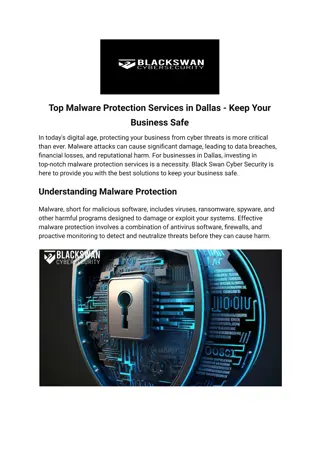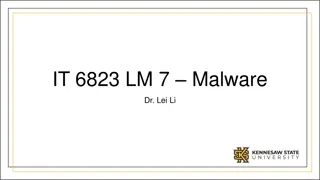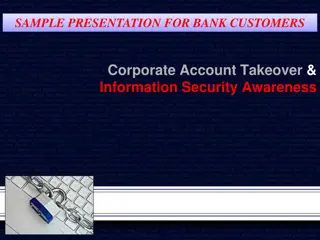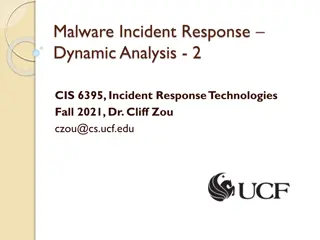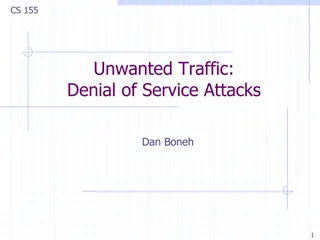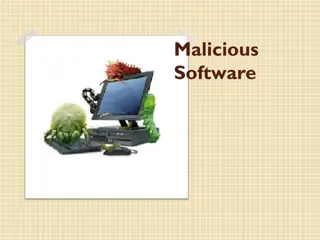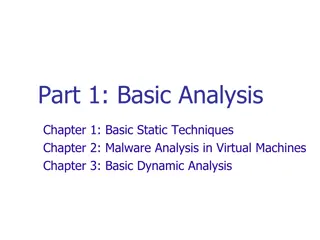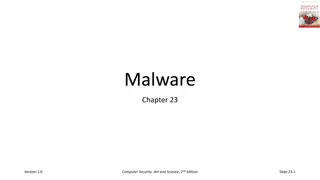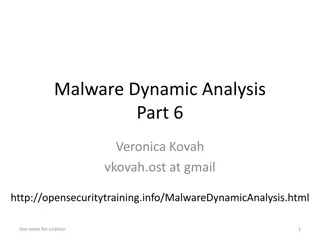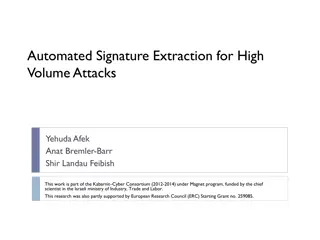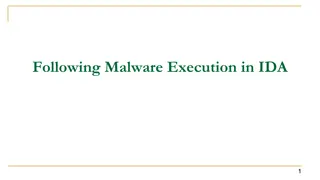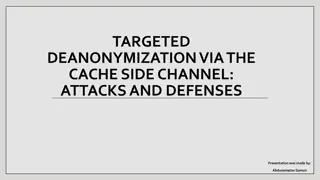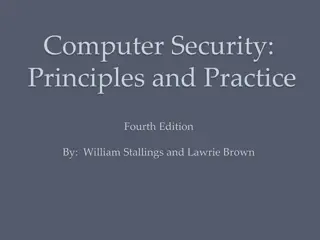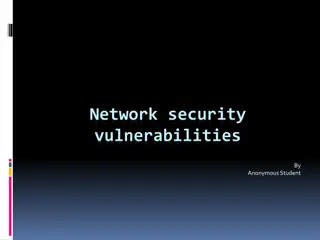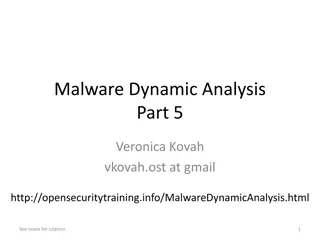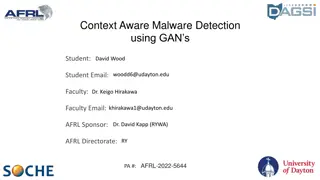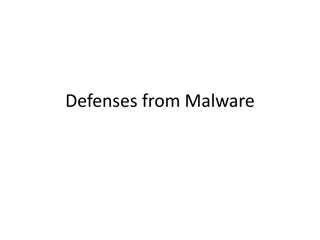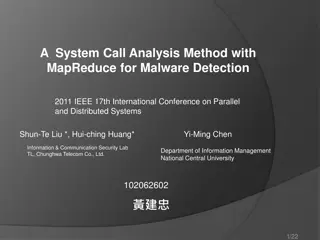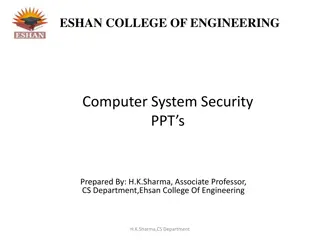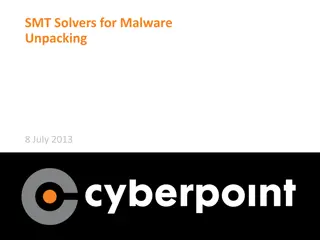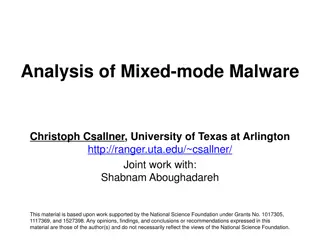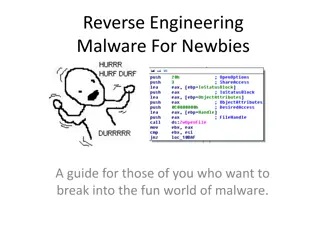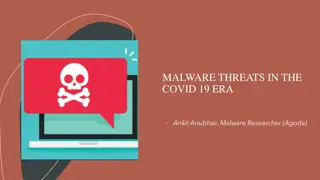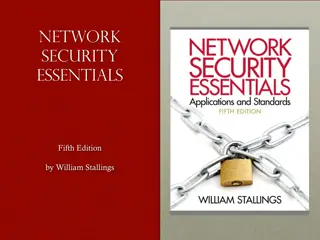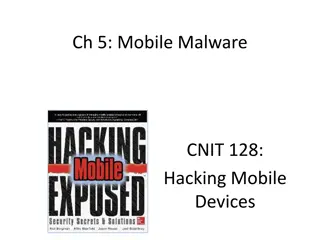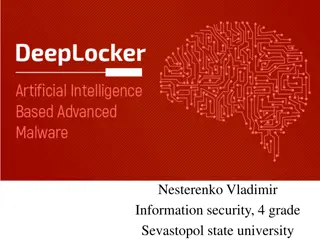Types Cyber Attacks: Cyber Security Training Workshop
Join our Cyber Security Training Workshop to learn about different types of cyber attacks such as social engineering attacks, DDoS attacks, malware attacks, MitM attacks, APTs, and password attacks. Enhance your knowledge and skills in cyber security.
15 views • 45 slides
Adversarial Machine Learning in Cybersecurity: Challenges and Defenses
Adversarial Machine Learning (AML) plays a crucial role in cybersecurity as security analysts combat continually evolving attack strategies by malicious adversaries. ML models are increasingly utilized to address the complexity of cyber threats, yet they are susceptible to adversarial attacks. Inves
2 views • 46 slides
Top Malware Protection Services in Dallas - Keep Your Business Safe
If you are searching for the best Malware Protection in Dallas, then you are in the right place. For all your Cyber Security needs look no further than Black Swan Cyber Security. As cyber threats continue to evolve, it is important to prevent the introduction of malicious code that can compromise th
2 views • 3 slides
Understanding Malware: Types, Risks, and Prevention
Dive into the world of malware to explore major types such as viruses, worms, ransomware, and more. Learn about social engineering tactics, insider threats, and best practices to safeguard against malware attacks. Discover the malicious intent behind grayware and how to prevent malware infections ef
0 views • 23 slides
Managing Covid-19 Cyber and Data Protection Risks
Exploring the risks and challenges related to cyber attacks and data protection amidst the Covid-19 pandemic. The agenda covers an overview of cyber-attacks, recent developments, protections against cyber attacks, data protection concerns during lockdown, compliance steps, and employee rights issues
1 views • 35 slides
Mitigation of DMA-based Rowhammer Attacks on ARM
Practical strategies are presented in "GuardION: Practical Mitigation of DMA-based Rowhammer Attacks on ARM" to defend against Rowhammer attacks on ARM architecture. The paper discusses Rowhammer defenses, RAMPAGE attacks on Android OS, and introduces GuardION as a lightweight mitigation approach. I
0 views • 48 slides
Corporate Account Takeover & Information Security Awareness Presentation
Discover the threat of Corporate Account Takeover, a growing electronic crime, where cybercriminals utilize malware to fraudulently access and transfer funds from corporate online banking accounts. Learn about malware, types of transactions targeted, and how criminals exploit victims through various
1 views • 25 slides
Understanding Malware Analysis with OllyDbg: A Practical Approach
Explore the fundamentals of malware analysis using OllyDbg, a user-mode debugger, for dynamic analysis. Learn how to dissect malicious code, analyze its behavior, and uncover hidden secrets within malware samples. Discover the powerful features of OllyDbg and its role in incident response and cybers
0 views • 17 slides
Understanding Malware: Types, Usage, and Protection
Malware, short for malicious software, encompasses various forms of hostile software designed to disrupt computer operation, steal sensitive information, or gain unauthorized access. It includes viruses, trojan horses, worms, spyware, phishing, ransomware, and more. Malware is often used to steal pe
1 views • 49 slides
Understanding Denial-of-Service Attacks and Defense Strategies
Denial-of-Service attacks pose a serious threat where attackers flood networks with traffic, leading to system crashes and slowdowns. Explore the impact, expected results, and various categories of DoS attacks such as bandwidth attacks, protocol exceptions, and logic attacks. Learn how to defend aga
0 views • 61 slides
Understanding Network Denial of Service (DoS) Attacks
Network Denial of Service (DoS) attacks aim to disrupt services by overwhelming them with traffic. These attacks can occur at various layers of the network stack and exploit weaknesses to achieve their goal. Amplification attacks, such as the Smurf attack and DNS Amplification attack, can significan
2 views • 52 slides
Preventing Active Timing Attacks in Low-Latency Anonymous Communication
This research addresses the vulnerabilities of onion routing to timing attacks and proposes solutions to prevent active timing attacks, focusing on low-latency anonymous communication systems. Various problems related to timing attacks in onion routing are analyzed, including the role of adversaries
0 views • 52 slides
Understanding Malware: Definitions and Types
Explore the diverse world of malware with definitions, categories, and examples such as self-replicating malware, population growth, parasitic malware, logic bombs, trojans, backdoors, viruses, and more. Gain insights into the characteristics and behaviors of different types of malware to enhance yo
0 views • 21 slides
Understanding Malicious Software and Its Impact on Computer Systems
Malicious software, commonly known as malware, poses a serious threat to computer systems by exploiting vulnerabilities. This content covers various terminologies, categories, and types of malware, including viruses, worms, rootkits, spyware, and adware. It also delves into how malware can cause dam
0 views • 16 slides
Strategies to Protect School Systems from Cyber Attacks
Schools are increasingly becoming targets of cyber attacks, making cybersecurity measures crucial. The article discusses the importance of responding to cyber attacks, creating incident response plans, and being vigilant against interception attacks. It outlines the steps to detect, document, and mi
0 views • 21 slides
Comprehensive Malware Analysis Techniques
This detailed guide covers basic static techniques, malware analysis in virtual machines, and basic dynamic analysis. It includes information on static analysis, such as examining payloads without execution, file signatures, and signatures generated via analysis. Additionally, it delves into counter
0 views • 17 slides
Understanding Malware and Computer Security
Exploring the world of malware and computer security, this content delves into different types of malware such as Trojan horses, viruses, worms, and rootkits. It discusses how malware can violate site security policies and the covert actions they can carry out without detection. Examples like the Ge
0 views • 127 slides
Malware Dynamic Analysis Part 6 Overview
This content provides insights into Malware Dynamic Analysis Part 6 by Veronica Kovah. It covers actionable outputs like Yara and Snort, utilizing the open-source tool Yara to identify and classify malicious files based on patterns. The Yara signatures discussed include rules, identifiers, and condi
0 views • 25 slides
Understanding Malware: Types, Symptoms, and Countermeasures
Malware is malicious software that can alter computer settings, behavior, files, services, ports, and speed. Sources of malware include insufficient security, honeypot websites, free downloads, torrents, pop-ups, emails, and infected media. Symptoms of malware include unusual computer behavior, slow
0 views • 9 slides
Automated Signature Extraction for High Volume Attacks in Cybersecurity
This research delves into automated signature extraction for high-volume attacks in cybersecurity, specifically focusing on defending against Distributed Denial of Service (DDoS) attacks. The study discusses the challenges posed by sophisticated attackers using botnets and zero-day attacks, emphasiz
0 views • 37 slides
Understanding Malware Execution and DLLs in IDA
Exploring how malware executes in IDA Pro, the significance of control flow graphs, DLL review, methods of utilizing DLLs for malicious activities, analyzing DLLs for code execution, and the management of processes in a secure environment. Gain insights into malware behaviors involving DLLs and proc
0 views • 27 slides
Targeted Deanonymization via the Cache Side Channel: Attacks and Defenses
This presentation by Abdusamatov Somon explores targeted deanonymization through cache side-channel attacks, focusing on leaky resource attacks and cache-based side-channel attacks. It discusses the motivation behind these attacks, methods employed, potential defenses, and the evaluation of such att
0 views • 16 slides
Understanding Malicious Software in Computer Security
In "Computer Security: Principles and Practice," the chapter on Malicious Software covers various types of malware such as viruses, adware, worms, and rootkits. It defines malware, Trojan horses, and other related terms like backdoors, keyloggers, and spyware. The chapter also discusses advanced thr
0 views • 49 slides
Understanding Network Security Vulnerabilities and Attacks
Explore the world of network security vulnerabilities and attacks, including Denial-of-Service (DoS) and Distributed-Denial-of-Service (D-DoS), security flaws in the TCP/IP protocol suite, ICMP attacks, routing attacks, and TCP attacks. Learn about common security vulnerabilities such as address spo
0 views • 36 slides
Understanding Malware: Types, Risks, and Removal Methods
Explore the world of malware, including its various types and how it infiltrates systems. Discover the dangers it poses, such as data theft and system hijacking, and learn about manual removal techniques using tools like MBAM. Dive into hands-on labs to analyze, detect, and eliminate malware for a s
0 views • 15 slides
Understanding Malware Analysis Using Cuckoo Sandbox
Dive into the world of malware analysis with a focus on using Cuckoo Sandbox, an open-source automated system for analyzing various types of malicious files. Explore the process of setting up, customizing, and running analyses on different malware samples to generate actionable outputs. Learn how to
0 views • 22 slides
Context-Aware Malware Detection Using GANs in Signal Systems
This project focuses on detecting malware within signal/sensor systems using a Generative Adversarial Network (GAN) approach. By training on normal system behavior and generating fake malware-like samples, the system can effectively identify anomalies without relying on signature-based methods. The
0 views • 10 slides
Analyzing Android Applications for Malware Detection
Android applications have become a prime target for cybercriminals, leading to an increase in Android malware. The authors introduce a mobile sandbox for automated analysis of Android apps, combining both static and dynamic methods. Static analysis inspects downloaded apps and their source code, whi
0 views • 20 slides
Strategies Against Malware Attacks
Learn effective defenses against malware including preventing exploits, utilizing non-executable memory, combating return-oriented programming, implementing ASLR, and more to enhance your system's security against cyber threats.
0 views • 42 slides
Understanding Malware: Types, Risks, and Prevention
Malware, short for malicious software, is designed to disrupt, damage, or gain unauthorized access to computer systems. Malware includes viruses, worms, trojans, ransomware, adware, spyware, rootkits, keyloggers, and more. They can be spread through various means like malicious links, untrusted down
0 views • 15 slides
MapReduce Method for Malware Detection in Parallel Systems
This paper presents a system call analysis method using MapReduce for malware detection at the IEEE 17th International Conference on Parallel and Distributed Systems. It discusses detecting malware behavior, evaluation techniques, categories of malware, and approaches like signature-based and behavi
0 views • 22 slides
Evaluating Android Anti-malware Against Transformation Attacks
This study evaluates the effectiveness of Android anti-malware solutions against transformation attacks, focusing on the resistance to various types of malware obfuscations. It explores different transformations such as repacking, trivial changes, and sophisticated obfuscation techniques. Ten popula
0 views • 23 slides
Understanding Computer System Security Threats and Malware Types at Eshan College of Engineering
Explore the world of computer system security threats and malware at Eshan College of Engineering through insightful presentations prepared by Associate Professor H.K. Sharma from the CS Department. Learn about security threats like intrusion, phishing, spyware, spam, and malware categories such as
0 views • 13 slides
Exploring SMT Solvers for Malware Unpacking
In this informative content, we delve into the world of malware analysis, binary packers, and the challenges posed by obfuscation techniques. The article discusses tools like UPX and Themida, as well as the complexities of virtualization and handler obfuscation in unpacking malware. Understanding th
0 views • 24 slides
Analysis of Mixed-Mode Malware and Malware Analysis Tools
This analysis delves into mixed-mode malware, detailing its two phases and potential impact on malware analysis tools like TEMU. It explores scenarios where malware attacks analysis tools, emphasizing the challenges faced in observing and preventing malicious behavior. The study also highlights vari
0 views • 14 slides
Introduction to Malware Reverse Engineering
Explore the fundamentals of reverse engineering malware in this comprehensive guide for beginners. Covering topics like x86/64 ASM basics, setting up an environment, using debuggers, malware analysis techniques, and essential tools needed for the trade. Learn about the importance of software breakpo
0 views • 35 slides
Emerging Malware Threats in the COVID-19 Era
Malware researcher Ankit Anubhav discusses the challenges and evolving tactics in combatting malware threats during the COVID-19 era. Insights include remote work vulnerabilities, social engineering tactics, and recent malware techniques to stay vigilant against. The discussion covers specific attac
0 views • 11 slides
Understanding Malicious Software: Classification and Payload Actions
Malicious software, or malware, can be broadly classified based on how it spreads and the actions it performs once on a target system. This classification includes distinctions between viruses, worms, trojans, botnets, and blended attacks. The payload actions of malware can range from file corruptio
0 views • 44 slides
Rise of Mobile Malware: A Historical Perspective
Explore the evolution of mobile malware from early instances like LibertyCrack in 2000 to more recent threats like DroidDream in 2011. Learn how malicious software has targeted mobile devices, such as Palm OS and Symbian phones, and understand the tactics used to infect and control these devices. Di
0 views • 38 slides
Understanding DeepLocker Malware and AI-Embedded Attacks
Security researchers at Sevastopol State University have developed DeepLocker, a sophisticated malware that leverages artificial neural networks to conceal its activation conditions and evade detection. The malware utilizes deep neural networks to function, making it difficult to detect and analyze.
0 views • 13 slides


